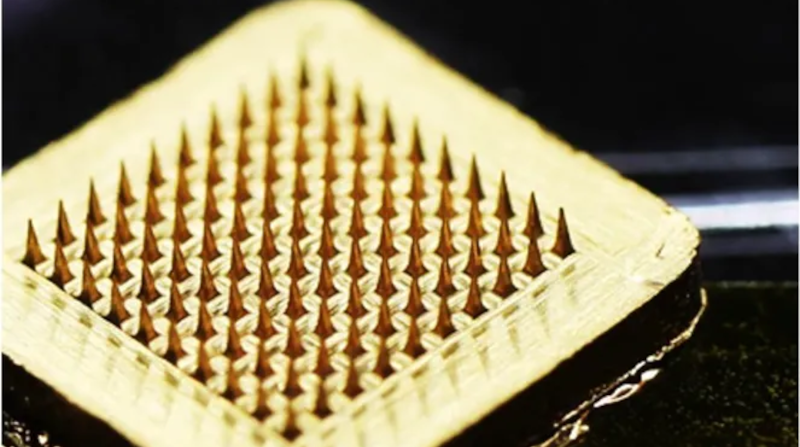We often look at news out of the research community and think, “we could build that.” But the latest brain-machine interface from an international team including the Georgia Institute of Technology actually scares us. It uses an array of tiny needles that penetrate the skin but remain too small for your nerves to detect. Right. We assume they need to be sterile but either way, we don’t really want to build a pin grid array to attach to your brain.
It seems the soft device is comfortable and since it is very lightweight it doesn’t suffer from noise if the user blinks or otherwise moves. Looking at the picture of the electrodes, they look awfully pointy, but we assume that’s magnified quite a few times, since the post mentions they are not visible to the naked eye.
By using machine learning, people were able to control virtual reality tasks with high accuracy — about 93%. Controlling things via brainwaves is nothing new, but the challenge has always been getting an easy and robust way to read the brainwaves to begin with. Obviously, this kind of technology could really help adaptive technology where using traditional control methods isn’t feasible.
We’ve seen brain control used to drive a car. We’ve even seen an Arduino get in on the act.
















If they’re not visible to the naked eye, they can’t be long enough to go very far into your skin. I’d wear it. It must be better than dealing with shaving your head or using jelly on electrodes.
Depends on what flavor of jelly, I think.
you know it’s going to be grape.
Oh, you will wear it for sure! On the next enhanced interrogation session.
Yep. This kind of thing will be mandatory in the near future, that’s the way things are going.
“But, if you’ve got nothing to hide…” etc etc.
If reality was scifi, each of the needles would grow a long fiber into your brain. Maybe all of that tin whisker research will finally have a purpose..
How did the Tripod caps work?
In “Stranger from the Depths” they had a teaching machine, I seem to recall it drilled multiple tiny holes in your skull.
Wouldn’t it be better to place the interface under tge skull, and have an optical jack for the interface? So much easier to connect to yiur cyberdeck.
No need to make it mandatory. Enable it to pay your online shopping through your smart phone and everyone will use them even when told Big Fruity will at the same time store all your thoughts.
As someone who spent a lot of time in a hospital with thumbtack-style electrodes glued to his head, something like this would be a MASSIVE improvement. I spent a long time in a room with someone forcing my hair in different directions to get at my scalp, stick a small round thing there, then push it to the point where I could feel it stab through my scalp. Then, paint a bunch of glue on so it doesn’t move. Repeat about 20 more times…
All the spikes must be one electrode, because EEGs have such poor spatial resolution that you’d be massively oversampling otherwise. It’s definitely supposed to look like a Utah array though.
You ALL, will become ONE, with the BORG!
It seems at the moment that there is nothing I can write into an SF novel that someone doesn’t actually invent before the book comes out.
Can you please right a story about how all of the peoples of earth united together at once for the betterment of all life on earth?
They’re writing science fiction, not Science Fantasy.
Elon’s device intentionally uses flying electrodes with AI for placement, because the distance varies,
also min 64×64 resolution.
So this spiky thingy is far from application.
https://www.youtube.com/watch?v=CLUWDLKAF1M
Hold my beer. (Because there’s a decent chance I’m about to permanently lose fine motor control.)
+1
+1
“we don’t really want to build a pin grid array to attach to your brain.”
Well, considering the alternative; a ball grid array reflowed to your brain…
This has been going on for maybe half a century. See John C. Lilley’s research on monkeys.
As for “can’t penetrate the skin” that’s simple: you simply cut a piece out of the subject’s skull.
Just like circumcisions are performed on about 20-90% of eligible newborn infants, implantation of cerebral wireless electrodes will be expected in the not too distant future to 100% of all newborns. Probably.
Too much paranoia on her I think. Chips like this have many potential benefits to all mankind, think of amputees being able to control a robotic limb by a direct neural link, blind people being able to see using artificial eyes connected directly to a chip in the right brain location; defeating alzheimers and other degenerative brain conditions by using this tech to skip over the bad brain segments…
I wonder what the chance of developing cyberbrain sclerosis on the implant site is.
Fun story:
One of my professors was telling me about back in the early 2000s, how he and a team were on the forefront of nanofabrication and were showing off their nano-needles at a tech conference. They were so tiny they just looked like fuzz on the silicon wafer, and you could painlessly stick the wafer to your finger.
It took about 50 or so people trying this before they realized they were effectively “sharing needles” with everybody and they had to shut down their display.
I just read this article, and I don’t get how this works. Did I miss something? Does it go on my finger? Or do they have to actually open my cranium to put this on my brain? And how does the interfacing actually happen? And what kind of direction? Am confused…